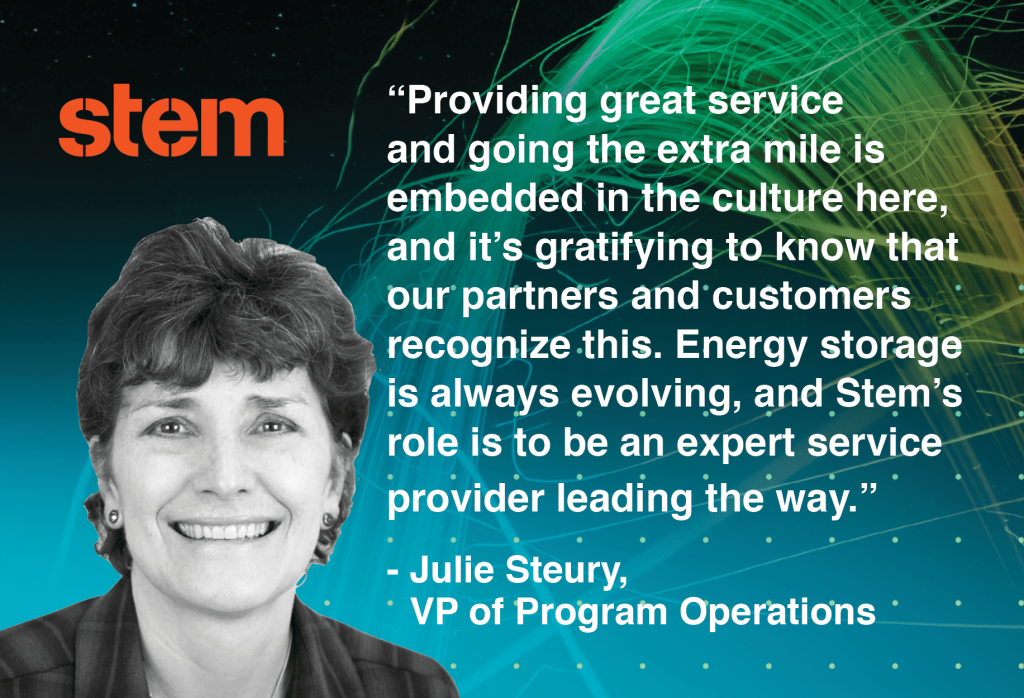Q: Tell us about yourself and your background.
I got started in the utility industry after getting a scholarship in high school, which then led into three college summers. I worked at Washington Water Power, in the power supply department, calling utilities throughout the Pacific Northwest and then manually (manually!) calculating water flows so we could predict hydropower generation.
After that I spent most of my career in software and software-based consulting for the utility industry. Some of my earliest projects were for the Electric Power Research Institute (EPRI), looking at large-scale battery energy storage systems and electric vehicles – both of which are now finally much more mainstream. That only took 30 years!
Stem encapsulated all the expertise I’d built up over my career – tariffs, batteries, load forecasting, demand response, software, utilities, and so on – and also gave me a chance to work on clean energy and climate. Nowadays batteries are paired with solar much more often than when I first started working at Stem, five and a half years ago.
Q: What is your job at Stem?
I run the Program Operations team, which includes Customer and Partner Operations as well as Data Operations. I got hired to co-launch the Program Management team after Stem won a big utility contract with Southern California Edison (SCE), and it expanded from there.
“Programs” are basically any structured opportunity for Stem systems to earn revenues by providing specific services to a utility or wholesale market. Two of the best-known programs are in California: the Local Capacity Requirement (LCR), which I just alluded to, provides capacity to SCE, and the California Self-Generation Program Incentive (SGIP) compensates storage for operating under certain parameters (notably, reducing GHG emissions). Increasingly, Stem programs involve providing services to wholesale energy markets and to utilities, such as electric cooperatives, who are newer to energy storage.
A typical day is busy! With hundreds of customers and dozens of programs, there’s a lot that needs to be reviewed and approved, plus a lot of coaching and advising for my 18-person team. I have probably too many meetings and would like to carve out more time to think and strategize. I’m always focusing on how to improve, and I’m a believer in positive, incremental changes. Better results don’t come from “big bang” moments, in my experience.
Q: What’s the most interesting thing you’ve worked on lately?
Related to California programs, we’ve been brainstorming ideas for the new California Requests for Offer (RFOs), and what makes this interesting is how much things have changed in three years. In 2018, California thought it had plenty of capacity, and the prices reflected that. Then last summer happened – the heat waves, wildfires, and blackouts – and now the California Public Utilities Commission (CPUC) and California utilities are much more interested in what energy storage can do for utilities and their customers.
So my team and I have been thinking about ways our existing energy storage systems can provide more value to the grid, which in some cases would involve loosening some operating and contractual constraints on those systems. It’s an interesting puzzle, and if we get it right it’ll be a win-win across the board.
Q: What recent industry trends have made a big impression on you?
There are so many. In California, watching natural gas be eliminated as a home fuel in more and more cities, which has tremendous implications for the industry. The Texas power crisis, which was terrible but will hopefully lead to a stronger grid and a bigger role for renewables and storage. The ever-increasing number of U.S. states, cities, and companies setting net-zero carbon goals, and even China has set a goal. The Biden administration’s focus on green infrastructure, jobs, and climate is a welcome change, and something we’ve seen hints of in past administrations – let’s hope this time it’s real, and deep, and permanent.
It’s also clear that long-duration storage will play an important role in decarbonizing electricity, and I’m interested to see what Stem might do there. The practical experience Stem has with operating different types of energy storage systems is second to none, and will be an invaluable asset to us as we grow.
Q: Any advice for younger professionals interested in this space?
I would say to always keep learning, and stay open to lots of different kinds of roles. Lateral moves can be a really good thing and provide valuable experience. One thing I’ve noticed among younger professionals is what I call the “race to a title,” where people try to advance as fast as possible early in their careers, but I’d recommend rounding out your experiences and gaining breadth and depth in your roles and skill set. Also, don’t write off working at a utility; I’ve sensed some negativity towards utilities in the renewables space, but utilities have a lot of valuable experience and credibility, and you could learn a lot by working there.
And finally, team matters. Work for companies with good, smart people who want to help each other and help the business.
Q: What about Stem would you want our customers and partners to know?
That Stem is a great company in such a dynamic space. We’ve experienced a tremendous evolution of the industry and the company and our capabilities, and we’ve done a good job of staying connected with our earlier customers while continuing to move forward and enter new markets. Providing great service and going the extra mile is embedded in the culture here, and it’s gratifying to know that our partners and customers recognize this. Energy storage is always evolving, and Stem’s role is to be an expert service provider leading the way.
For me, a good day at work is one where I learn something new and get smarter about some part of our business. At Stem, even after five-plus years, that’s most days!
